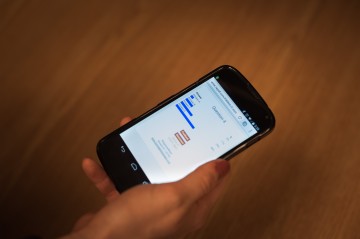It’s obvious that a piece of educational technology has caught on when learners start asking to use it. MedIT technicians have observed this with Audience Response System (ARS) technology – but with a twist.
This year, medical undergraduates in their fourth and final year of the program requested to use ARS to vote for their class valedictorians (one for each program site). The entire class assembled over videoconference and voted, one site at a time, for the four class representatives who would hold this prestigious honour.
What is ARS?

Students using “clickers” for an ARS session.
ARS works alongside presentation software to allow audiences to participate by submitting responses to interactive questions using a response card or their personal device. The service, as provided by MedIT to the MD undergraduate program, is typically used to assess learner understanding throughout a lecture. The instructor asks a prepared question, the learners select their answers using their voting device, and the results can appear on screen immediately after the instructor ends the poll. This method can provide multiple benefits for instructors and learners:
- Increased audience engagement. Learners become active participants in the lecture, with the results that they’ve helped produce being displayed in real-time, regardless of their location in the province.
- An instant method to gauge understanding. ARS helps to avoid the “crowd psychology” effect of hand-raising, as the results are anonymous. Learners pick the answer they believe to be correct, instead of the most popular one. This allows instructors to identify and address general areas of weakness for the class, and individuals can assess their own areas of strength and weakness.
- Easy data gathering and reporting. ARS answers are recorded anonymously and can be compared over time, whether from the beginning of a lecture to the end of it, or from one year to the next.
Alternative Uses

ARS can also work with web-enabled devices.
It’s not just the medical students who are using ARS in creative ways; instructors are, too. Dr. Claudia Krebs is using ARS in her flipped classroom approach. Learners view a video that explains core concepts prior to the lecture, and then use ARS at the beginning of class for a “readiness assessment.” Through this assessment knowledge gaps are identified and the instructional approach is adjusted accordingly.
ARS has also been used as a simple and effective tool to illustrate core concepts. In a “Doctor, Patient and Society” session held this year the presenter polled the audience to gauge their reactions to a variety of faces shown on screen. A 1-5 scale was used, where 1 represented discomfort and 5 represented comfort. They were able to informally demonstrate how reactions to physical appearance can impact judgement in a way that was engaging and easy to relate to.
There are many ways that you can incorporate ARS into your MD Undergraduate Lecture. If you are interested in learning more, please contact the MedIT Service Desk (1.877.266.0666).